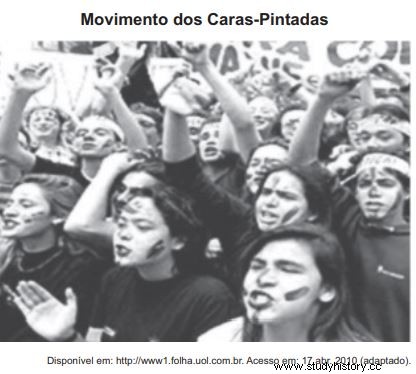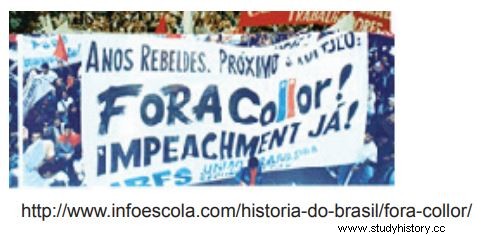 The movement represented in the image, from the early 1990s, snatched thousands of young people in Brazil. In this context, the youth, moved by a strong civic feeling, joined the opposition parties and organized the Diretas Já campaign. B) spoke out against corruption and pressed for the passage of the Clean Record Law. C) engaged in the lightning protests and used the internet to schedule their demonstrations. D) mirrored the student movement of 1968 and carried out armed revolutionary actions. E) became a spokesperson for society and influenced the impeachment process of then-President Collor.
The movement represented in the image, from the early 1990s, snatched thousands of young people in Brazil. In this context, the youth, moved by a strong civic feeling, joined the opposition parties and organized the Diretas Já campaign. B) spoke out against corruption and pressed for the passage of the Clean Record Law. C) engaged in the lightning protests and used the internet to schedule their demonstrations. D) mirrored the student movement of 1968 and carried out armed revolutionary actions. E) became a spokesperson for society and influenced the impeachment process of then-President Collor.Question 02 - TJ-GO - 2013 - TJ-GO - Assessor Justice Officer - The painted faces were:(a) A student demonstration that demanded the end of the military regime. (b) A student demonstration demanding the impeachment of President Collor. (c) A popular demonstration that demanded the elaboration of the Federal Constitution of 1988. (d) A popular demonstration that demanded the reestablishment of direct elections for President of the Republic and ended the Electoral College, being this demonstration also known as "Diretas Já" .
Question 03 - VUNESP - 2013 - FUNDUNESP - Historiographer -Caras Pintadas was the name given to young people and students who painted their faces with the colors of the national flag and took to the streets in marches organized by them in favor(A) of redemocratization in the country and direct elections for President of the Republic.(B) ) of the impeachment of the then President of the Republic, accused of complicity in crimes of illicit enrichment, foreign exchange evasion and influence peddling. (C) better teaching conditions in the country's public federal universities. (D) broad, general and unrestricted amnesty for Brazilian political prisoners and exiles. (E) better health conditions for the population victim of droughts in the northeast of the country. Brazil.
Question 04 - CECIERJ - 2016 - CEDERJ - Entrance Exam - The figure below shows one of the most important popular demonstrations of the 20th century, the Caras Pintadas movement, which defended the impeachment of then president Fernando Collor de Melo. Regarding this popular manifestation, it is correct to say:

(A) It was an exclusive movement of the medium sectors and, in particular, of the representatives of the great capital.(B) It meant the manipulation of the media sectors, especially the Rio de Janeiro and São Paulo newspapers.(C) It expressed the performance of Brazilian parliamentarians to put an end to corruption in the country.(D) It had the decisive presence of young people, many affiliated to the National Union of Students and the Brazilian Union of Secondary Students.
Question 05 - Machado de Assis Institute - 2014 - Palmeiras do Tocantins City Hall - TO - Regarding the “Caras Pintadas” movement, mark the WRONG alternative. support for the government and, ultimately, for the country, doing so extensively, using a "t-shirt or any item of clothing in the colors of our country", as the president would say in his infamous speech.B) Amidst all the clamor to this popular participation, seeking to somehow make up for lost time in the midst of the doldrums of the years of repression, the media and public opinion intensely relived the moments in which the population somehow revolted against the arbitrariness of the regime of exception, and among the great moments of the struggle for democracy in the country were the student protests of the late 60s, where university students just over 18 years old took to the streets to openly protest against the government, demo demonstrating high organization, intellect and politicization, expressing generally left-wing ideas, many of whom lost their lives, were arrested, or relegated to hiding, or even lost their political and social rights. C) The press would coin the term guys- painted to such young people, making them icons of popular contentment against the constituted power, but, unlike the politicized and militant movement of the past, the protests of 20 years later took on a tone of humor, irony, anarchy and a not so marked. D) The "painted faces" movement consisted of crowds of young people, mostly teenagers, who took to the streets across the country with painted faces in protest over the dramatic events that had been shaking the government of then-President Fernando Collor de honey
Question 06 - UNIFAL - The second half of the 20th century was marked by political actions characteristic of youth, both in terms of cultural changes (language, behavior, music, cinema) and student organization (secondary and university movements). In this context, mark the INCORRECT alternative. A) The Brazilian student movement was extremely active in the Brazilian political scenario during the military dictatorship. A portion of the university students linked to popular or religious movements (Juventude Universitária Católica - JUC) was engaged in popular education, aiming, in addition to literacy for young people and adults, their awareness and, also, the struggle for social transformations.B) Mottos such as “it is forbidden to prohibit”, popularized in Brazil through songs and cultural manifestations, refer to demands and protests spread by Parisian students, forming part of the counterculture movements of the 1960s, known as “May 68”. ) In the United States, several demonstrations for peace were made during major musical events, involving the trio:sex, drugs and rock and roll. Even so, part of this generation, which became known as the hippie, was considered by many left-wing political activists as alienated, as they refused to participate in organized social movements. D) The moment of greater conscious intervention of university youth in the political scene The Brazilian movement, which took place in the 1990s, was the movement of the “painted faces” that, throughout President Fernando Collor de Melo’s term, supported denunciations, articulated with unions and, even without the support of the media, took this president to resignation of the mandate.
In Brazilian political history, the movement of students "faces painted", calling for ethics and morality in public life, is related to
(A) popular support for the constitutional amendment which established direct elections for president.
(B) the successive economic shocks – Plano Cruzado, Plano Bresser and Plano Verão – promoted by the Sarney administration.
(C) the CPI of the Chamber, which investigated the complaints referred to (D) privatization of the state companies Vale do RioDoce, Usiminas and Petrobrás.
(E) complaints that the President of the Republic was involved with ghost account holders, accounting makeup and cold notes.
Question 08 - UFU 2011-2 - 2nd day - Painted faces was the name given to young people and students who, in August and September 1992, painted their faces green and yellow and organized marches for the impeachment of then president Fernando Collor de Mello. Painted faces, mark the INCORRECT alternative.
A) Underage students were excluded from the electoral political scene at that time, which stimulated the demand for the expansion of the right to vote carried out by the leadership of the UNE and the Party of Workers.
B) The mass media played an important role in the process of denouncing and investigating the corruption scheme of the Collor government, as well as in the dissemination of popular demonstrations for impeachment.
C) The movement in the streets of the cities it appeared as a response to Fernando Collor's appeal to the Brazilian population to wear green and yellow as a sign of support for the president; the population took to the streets dressed in black.
D) Collor built an image of an enterprising and modern man by exploiting his visibility in the media, he intended to print an image of administrative probity and was impeached for a crime of responsibility.
b>Question 09 - CEDERJ 2022.2 - In May 1992, the brother of President Fernando Collor de Mello, named Pedro Mello, denounced that there was a corruption scheme, influence peddling, ghost accounts, which involved the president and his political allies. The situation led to the creation of a Parliamentary Commission of Inquiry (CPI), promoted by the National Congress. In the political clash of the time, Collor called on the population to wear the colors of the national flag and his opponents encouraged the population to dress in black and take to the streets.
 The movement of thousands of young people who took to the streets in 1992 for the impeachment of President Collor de Mello, was known for:A) Come to the Street. B) Tenentism. C) Painted Faces. D) Free Pass. E) Direct Now.
The movement of thousands of young people who took to the streets in 1992 for the impeachment of President Collor de Mello, was known for:A) Come to the Street. B) Tenentism. C) Painted Faces. D) Free Pass. E) Direct Now.FEEDBACK 01 - E02 - B03 - B04 - D05 - C06 - D
07 - E
08 - A09 - C
